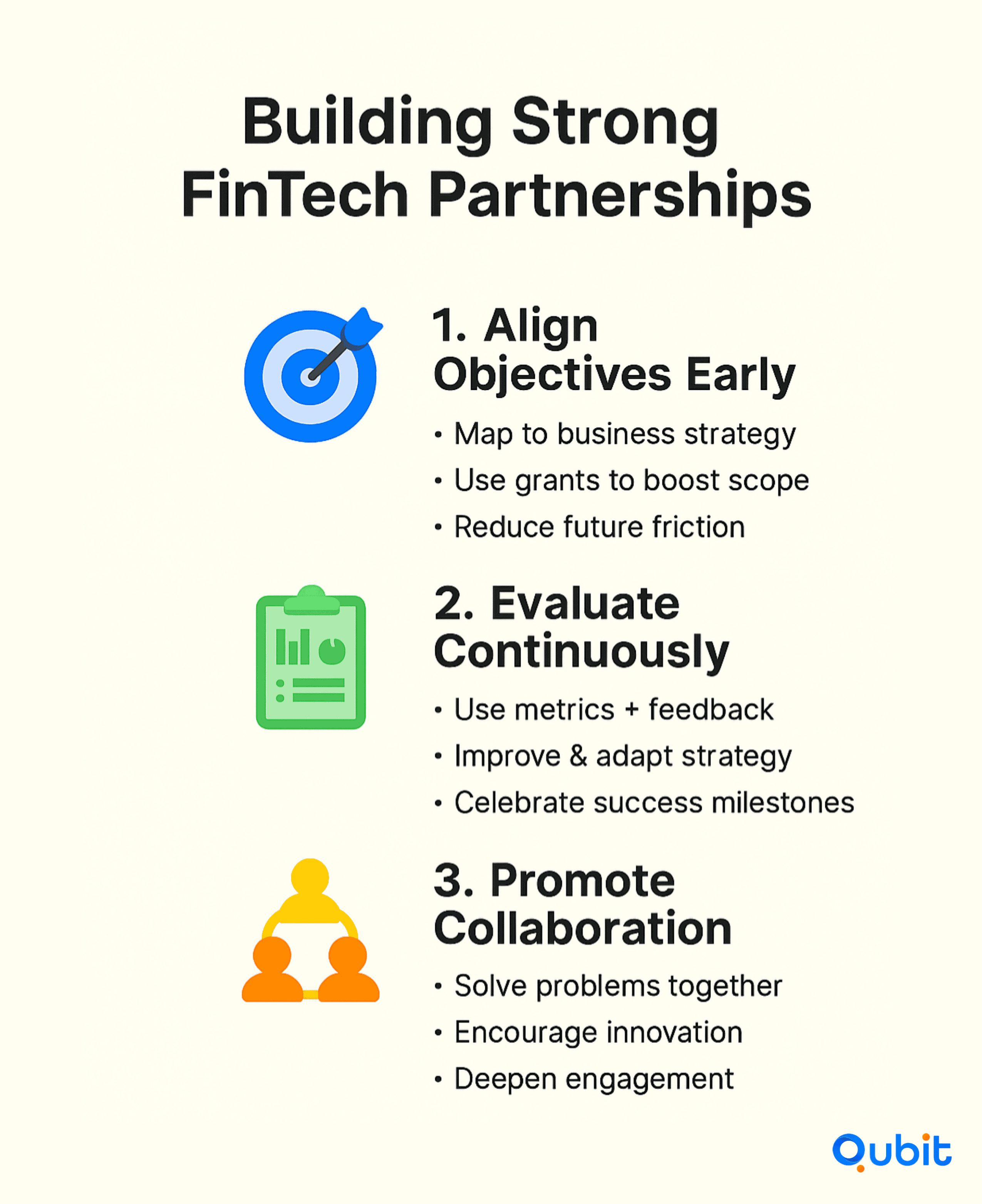Strategic partnerships have emerged as a cornerstone for growth in the FinTech sector, especially when it comes to securing funding. As reported by PwC, 82% of financial institutions plan to increase FinTech partnerships, highlighting the growing importance of collaboration in this space. These alliances not only provide access to capital but also open doors to shared expertise, expanded customer bases, and innovative technologies.
This blog explores how strategic partnerships can act as a catalyst for funding success in FinTech. From understanding the motivations behind these collaborations to examining real-world examples, we’ll uncover the key factors driving their effectiveness.
Let’s dive into the details and discover how FinTech companies are reshaping their financial strategies through partnerships.
Strategy to Excel: Fintech Partnership Models & Customized Solutions
Collaboration is at the heart of innovation in the FinTech sector, with partnership models playing a pivotal role in delivering tailored financial solutions. As 64% of banks prioritize digital banking partnerships, the demand for strategic collaborations has never been more evident.
Below, we explore three key partnership models and their impact on creating customized solutions and stabilizing high-risk ventures.

1. Referral Partnerships: Simplifying Client Acquisition
Referral partnerships are a straightforward yet effective model where FinTech companies and financial institutions collaborate to share leads. This approach allows FinTech firms to focus on their core offerings while benefiting from the established client base of their partners.
For example, a FinTech company specializing in payment processing can partner with a bank to gain access to its small business clients. In return, the bank earns referral fees, creating a win-win scenario. This model not only accelerates market penetration but also reduces the cost of customer acquisition.
2. Private/White-Label Partnerships: Enhancing Brand Identity
Private or white-label partnerships enable FinTech companies to offer their solutions under the branding of their partners. This model is particularly effective for financial institutions looking to expand their digital offerings without investing heavily in development.
For instance, a FinTech firm providing digital lending platforms can allow a bank to rebrand and integrate the platform into its ecosystem. This seamless integration supports the growing trend of Embedded Finance Proliferation, where financial services are integrated into non-banking platforms. Such partnerships empower FinTech firms to scale while allowing their partners to maintain brand consistency.
3. Hybrid Partnerships: Combining Strengths for Greater Impact
Hybrid partnerships blend elements of referral and private-label models, offering flexibility and shared benefits. These collaborations are ideal for addressing complex market needs, such as stabilizing high-risk ventures or launching innovative financial products.
For example, a FinTech start-up could collaborate with a bank to co-develop a new credit product. The bank provides funding and regulatory expertise, while the FinTech firm contributes technological innovation. This model not only diversifies revenue streams but also mitigates risks through shared responsibilities.
Supporting Funding Initiatives Through Partnerships
Strategic partnerships also play a crucial role in funding initiatives. While partnerships can stabilize high-risk ventures, exploring complementary funding avenues like fintech debt financing options can further enhance financial resilience. An analysis of fintech debt financing options clarifies how debt instruments can integrate with partnership efforts, further detailing one of the multiple funding paths available for FinTech start-ups.
Additionally, partnerships should be viewed as part of a broader fundraising strategy. The overview in fintech fundraising strategies and opportunities offers a broad perspective on the variety of funding avenues available, situating strategic partnerships within the wider FinTech funding landscape.
Avoid Pitfalls: Challenges and Considerations for Fintech Partnerships
Collaborations between FinTech companies and traditional banks offer immense potential but are fraught with challenges that demand careful attention. Misaligned risk appetites often emerge as a significant obstacle. While FinTech firms tend to embrace innovation and higher risk thresholds, traditional banks prioritize stability and risk mitigation. This disparity can lead to conflicting priorities, making it crucial for both parties to establish clear expectations and align their risk strategies early in the partnership.
Technology integration is another hurdle that cannot be overlooked. FinTech solutions often rely on cutting-edge platforms, while banks may operate on legacy systems that resist seamless integration. Tools like Integration, which streamline web-based solutions into mobile apps, can help bridge this gap by simplifying user experiences and ensuring compatibility across systems. However, achieving full interoperability requires meticulous planning and robust technical expertise.
Regulatory compliance adds yet another layer of complexity. As financial services increasingly move online, regulatory bodies are adapting to the fast-growing FinTech ecosystem. Ensuring compliance with stringent licensing requirements and evolving regulations is non-negotiable for both parties. Staying informed on the Evolving regulatory compliance landscape can help FinTech companies and banks align their strategies and avoid costly penalties.
To overcome these challenges, proactive planning and open communication are essential. FinTech firms and banks must prioritize seamless system integration, align their risk appetites, and stay ahead of regulatory changes to build successful partnerships.
Navigating Fintech Funding with Strategic Partnerships
The fintech industry is rapidly expanding, with projections estimating a market size of $882 billion by 2030, according to Fortune Business Insights. As businesses explore alternative financing options, understanding the nuances of strategic partnerships and funding solutions becomes essential.
1. Conduct Thorough Due Diligence
Before committing to any funding arrangement, customers must evaluate the credibility of potential partners. Research their track record, customer reviews, and compliance with industry regulations. For example, platforms like Backd Business Funding offer flexible lending options tailored to business needs, making them a viable choice for alternative financing.
2. Prioritize Transparency in Contractual Terms
Clear and detailed contracts are vital to avoiding unexpected costs or obligations. Customers should review terms related to repayment schedules, interest rates, and additional fees. Transparency fosters trust and ensures both parties understand their responsibilities.
3. Understand Costs Associated with Alternative Financing
Alternative financing solutions often come with unique cost structures. For instance, the discussion in revenue based financing fintech highlights how aligning cash flow with investor interests can be a strategic approach. Customers should weigh these costs against traditional lending options to determine the most sustainable path forward.
Strategic partnerships between fintech firms and traditional lenders are reshaping the funding landscape, offering businesses more tailored solutions. By exercising due diligence, prioritizing transparency, and understanding associated costs, customers can make informed decisions that align with their financial goals.
Roadmap to Success: The Mutual Benefits of Bank-Fintech Partnerships
Collaborations between banks and fintech companies are reshaping the financial industry, offering a wealth of opportunities for both parties. These partnerships enable banks to tap into fintech innovation while fintechs gain access to established customer bases and regulatory expertise.
Expanding Customer Reach and Accelerating Growth
Banks and fintechs can significantly broaden their market reach by combining resources and expertise. For instance, the Citi-Carlyle Fintech Funding Initiative demonstrates how co-investment strategies can fuel large-scale funding for fintechs, enabling them to scale rapidly.
Risk Mitigation and Reputation Enhancement
Strategic partnerships also help mitigate risks by pooling knowledge and resources. Banks benefit from fintechs' agility and technological advancements, while fintechs gain credibility through association with established financial institutions.
Driving Innovation Through Streamlined Processes
Innovation thrives in collaborative environments. Programs like the Mastercard Start Path demonstrate how streamlined onboarding processes can accelerate fintech adoption and innovation. By reducing barriers to entry, such initiatives create a fertile ground for new ideas and solutions.
Unlocking Non-Traditional Revenue Streams
Partnerships often uncover new revenue opportunities. By integrating fintech solutions, banks can offer enhanced services, such as personalized financial tools, that cater to evolving customer needs. Insights from alternative funding for fintech present additional approaches that complement strategic partnerships by expanding the range of financial models you may consider.
Strategy for Success: Tips for Building Lasting Fintech Partnerships
Establishing enduring fintech partnerships requires a thoughtful approach that prioritizes clarity, alignment, and adaptability. Here are actionable strategies to help you build strong, long-term collaborations:

1. Align Objectives Early
A shared vision is essential for a partnership to thrive. Take the time to identify common goals and ensure they align with your broader business strategy. This alignment not only streamlines decision-making but also minimizes conflicts down the line. For instance, exploring opportunities like fintech government grants can provide additional resources to achieve shared objectives, enhancing the partnership's value.
2. Implement Continuous Evaluation
No partnership is static. Regularly assess the performance of the collaboration against predefined metrics to ensure it remains beneficial for both parties. Use these evaluations to identify areas for improvement, celebrate successes, and adapt to changing market conditions.
3. Foster a Culture of Collaboration
Encourage a collaborative mindset by promoting knowledge sharing and joint problem-solving. This approach not only strengthens the partnership but also drives innovation, enabling both parties to stay ahead in the competitive fintech landscape.
Conclusion
Strategic partnerships have proven to be a powerful tool for securing funding in the FinTech sector. By aligning with the right collaborators, startups can unlock new opportunities, expand their market reach, and attract investors with greater confidence. Clear communication, a compelling narrative, and actionable steps are essential to building partnerships that deliver measurable results.
If you’re looking to turn strategic partnerships into investor conviction, at Qubit we understand co-selling motions, bank integrations, and shared KPIs. Advance your raise with our fintech fundraising assistance.
Key Takeaways
- Strategic partnerships in FinTech are essential for unlocking new funding opportunities.
- Various models, referral, white-label, and hybrid, offer tailored financial solutions.
- Challenges such as risk alignment and regulatory compliance require proactive planning.
- Clear communication and regular evaluations are vital for sustaining partnerships.
- Leveraging expert services like those from Qubit Capital can enhance funding success.
Frequently asked Questions
What are fintech strategic partnerships?
Fintech strategic partnerships involve collaboration between financial technology firms and external entities to offer integrated services, expand reach, or co-develop products. Examples include white-label banking and API integrations between banks and fintechs.






